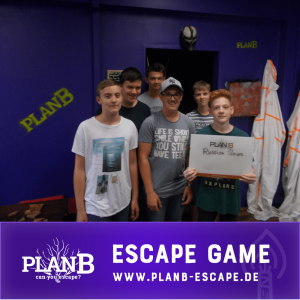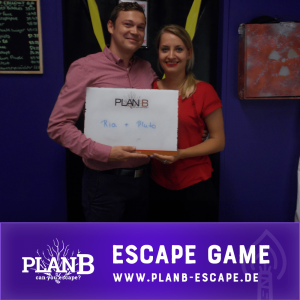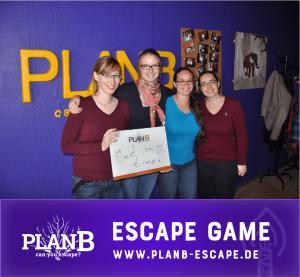All great Escape Rooms have certain things in common.
Do you know which ones?
The fact is, anyone can open an Escape Room.
But not everyone manages to create a really great Escape Room.
What’s the secret?
How can you take your Escape Room to the next level?
In this post, you can find 18 great ideas for improving your escape games and business practices that will keep your customers coming back for more.
Whether you’ve been running your Room Escape offering for a long time or are just getting started. Here you’ll find all the important tips on how to improve your Exit Game and turn a good Escape Room into a great Escape Room.
There are over 160 Escape Rooms in the UK, over 100 in Toronto and 140 in Amsterdam. New Escape Games open and close every month.
Where do you start when it comes to improving your success story?
What actually makes a great Escape Room? In this blog post you’ll find lots of ideas. You have to ask yourself a lot of questions and play as many exit rooms as possible before you can really get started. The following 18 tips range from designing a credible story to using technology to the player’s tension curve from start to finish. These are all things I’ve been experiencing for over a year in a particularly immersive escape room.
1. KNOW YOUR AUDIENCE.
Should your Escape Game be a family-friendly venue? Or are you more interested in creating horror-based escape rooms? Exit games with a high level of difficulty for enthusiasts? Or all this in one room?
You need to know your potential players and their experience and possible expectations of the Escape Game experience. Think carefully about the type of gaming experience you want to provide. Know your audience and write custom stories.
2. choose a suitable location.
The building in which your Escape Rooms are located can help to create a suitable atmosphere from the outset.
There are also limitations. But it’s already intuitively more exciting to descend steps to underground rooms than to climb stairs to the third floor.
It’s not just the rooms that should be suitable. A large sign with your logo on a magnolia wallpaper will certainly not create the right atmosphere.
Your reception and the corridors to the Escape Rooms should bear your signature. I have seen old walls, old castles, graffiti and murals.
3. WRITE THE STORY THAT FITS YOUR SPACE.
You could come up with the most ingenious Escape Room ever created. All plans will expire if the story doesn’t match the room.
Look at the possibilities of the room. Know its limits.
You have to stage a whole story and treat it like a construction project.
A good Escape Room is like an extraordinary architectural object.
4. CHOOSE BETWEEN A LINEAR OR A MULTILINEAR PUZZLE CONCEPT.
This should be determined by your space and your history.
Linear is very simple: solve a series of puzzles and escape.
Multilinear is – as you can see in the name – more difficult, but probably more intense, if you do it right. Christopher Nolan’s successful film Inception is often cited as an example of an incredible multilinear narrative.
Multi-linear designs can have multiple paths that all lead to one point. This means that players need to think more about it. Because they need to be able to connect and merge all the storylines.
5. CREATE A CREDIBLE STORY.
You have to build a credible story. To achieve this, you should create a world like a computer game, a movie or an exciting book.
Take Harry Potter or Game of Thrones as an example. Both have engaging characters and a world where everything from geography to tiny details has been carefully considered.
The whole must be interesting and meaningful for the players.
6. KNOW YOUR PROTAGONIST (IF THERE IS ONE).
The fact that you have to write the story for an exit room makes you an author. And what do authors do? They tell stories with a fascinating main character.
This is especially true for rooms of a certain type: when the theme of the escape room is ‘treasure hunter’ or ‘explorer’. Less so for rooms like a nuclear shelter.
If you have a character, you need to know everything about him or her, from appearance and personality to your favorite drink.
You don’t have to explain everything to the players. But you should know all the details to make your story credible.
7. A DESIGN FOR OPTIMAL FLOW AND SPEED.
A secret must be in the heart of the room.
The design of an escape game should guide the players from A to Z through the escape room.
You can do this by getting players to deal with what is around them, be it a grinning skull on a wall or a notebook full of strange symbols and equations. You can also succeed by increasing the difficulty level of the puzzles as you approach the starting point.
8. MAKE YOUR PUZZLES INTERESTING AND CHALLENGING – BUT SOLVABLE.
The players must be able to escape from the room within an hour.
If something is too dark or too hard to find or solve, it will take the fun out of the experience.
You need a good selection of puzzles.
Attention spans will decrease when players simply need to open padlocks or find keys. A mixture of logical, mathematical and creative puzzles that require you to think around the corner works well.
9. MAKE SURE THAT THE WRONG TRACKS MATCH THE TOPIC.
Escape rooms are simply said to be secrets that must be solved in order to gain freedom. And what is behind every classic secret? A wrong track!
Now a false trail could be something as simple as an object that looks as if it should be vital, but is actually only there for the show.
I was once deceived by a book that looked like it was full of important information. But it was a wrong track. But it fit the theme and the storyline of the room. So always keep in mind:
False tracks must also be credible.
10. GIVE HINTS WHEN AND IF NEEDED; BUT NEVER MAKE IT EASY.
Tips should point players to the solution – but don’t give them the solution.
Any hints you give should work within the narrative. Otherwise, players will lose the enormously important feeling of immersion.
Always remember that a clue is just that – a clue; not less, but not more.
Players should feel as if they are solving everything with a minimum of help. They should have that sense of satisfaction when they meet a challenge that motivates them and gives them the momentum to master the next challenge.
11. WORK WITH REFERENCES FROM POP CULTURE, PLAY AND FILM.
We’ve all seen Indiana Jones and James Bond. Maybe you want to develop a whole space around this theme.
References to pop culture create the feeling of being part of a popular movie or game. You can fulfill a fantasy – the players can live it instead of just watching.
12. INPUT AND OUTPUT SHOULD BE DIFFERENT!
The big must!
Trying to find a way to open the door through which players entered the Escape Room quickly gets old.
Creating a maze of doors, passageways, small chambers and rooms within the Escape Room is the best possible scenario.
Secret doors in the walls are good, but require some expertise.
13. MAKE SURE THAT THE FURNITURE AND DECORATIONS MATCH THE THEME.
A lot of puzzles in a room are boring, even if they are cleverly designed.
The theme must be recognisable down to the last detail.
Anything that doesn’t fit can become your Achilles verse.
A good example of this is the animated Disney film ‘Robin Hood’. There’s a balloon in it, but I’m pretty sure there weren’t any balloons in the Middle Ages.
Technology or no technology?
That’s the question here! Some rooms are equipped with a lot of technology today. Others have none at all.
The question of which option is preferable strongly depends on how you designed the room.
Personally, I think that the most innovative and immersive escape games are those where technology isn’t obvious. It is always subtly integrated into the set design.
Tablets in Escape Rooms
Another technology-related question: Should players be given tablets so they can stay in touch with you?
That depends on the type of room. If it would interfere with your immersion in the Escape game, then you’d be better off without a tablet.
Actors in Escape Rooms
Again, the answer is: Everything depends on your background story.
You’re never forced to let actors really enter the room. Sound effects and the belief that “someone” is coming are sometimes better than a real actor. If you choose it, the actor should really be convincing.
Loud banging on the walls, clattering, grunting, screaming; an actor (or one of your co-workers) is very suitable for all these things. Because the effect is much more realistic than a recording.
14. IMAGINE A FEELING OF COMPLETE IMMERSION.
To create a feeling of total immersion is the holy grail of the Escape game. If you manage to get players to fully immerse themselves in the story, you’ve made it to a truly great Escape Room. It takes time, imagination and expertise to achieve this.
Exit Games is about interacting with the fantasy world you’re in. I’ve already had to open doors without an obvious keyhole with a toilet flush.
Hiding things in dark rooms or holes can be useful. Players have to search in uncertain places; that gets the adrenaline going.
If you can, add sound effects:
If you can convince people that the experience is really real, you’ve really made it. Everything – from the story, to the theme, to the interaction with the players from outside the room – has to be pinpointed.
15. DON’T CONTROL THE GAMES FROM A LAPTOP AT THE RECEPTION DESK.
Interact with the players. Respond to it in real time. Be right behind the door.
Think of an escape room like a play. Your employees are like stage workers, pulling strings, making noises and triggering visual effects in the room.
Create the right level of pressure.
Players need to feel that time is running out.
16. LET THE PLAYERS GUESS TO THE END
Exit games always work with the element of surprise. These surprises must come to the end.
Mistakes can be okay.
If absolutely anyone who plays a game can quit in less than 25 minutes, then maybe you should ask the quality of your Escape Room question. The great thing about this experience is that you don’t have to break out successfully to have fun.
I haven’t managed to escape from an escape room a few times, but I had a great time.
17. YOUR MARKETING SHOULD BE AS UNIQUE AND EXCITING AS YOUR ESCAPE ROOM.
Marketing, of course, deserves its own post on this blog. But it’s still an important consideration to think about what makes a good Escape Room.
“Coming Soon teasers for social media are good.
Golden tickets, free tickets for a just opened Escape Room, are also worth considering. I know an Escape Game provider who still does marketing in the old-fashioned way: by simply going out on the street and giving away free tickets. It creates a sense of anticipation.
Don’t reveal everything on your website.
The blurb of a book doesn’t tell you the whole story. The same rule applies here. If you know too much about what to expect, you ruin the experience.
It must be a journey that begins before the players have entered the building.
18. RESIST THE ATTEMPT TO SIMPLY JUMP ON THE MOVING TRAIN
I’m talking about virtual reality here. With regard to the future of Escape Rooms, a lot has already been said about VR. But the technology is not yet fully developed.
Wait and see how Oculus Rift is accepted and evaluated by people who actually bought it before you invest in this technology.
AND NOW CREATE THE BEST GODDAMN ESCAPE GAME YOU CAN IMAGINE!
Very excited?
That should be you!
Remember the golden rule: Be imaginative. Don’t hold back. Escape players will remember the room that really captured their imagination and transported it to another world. Go out and make it!










